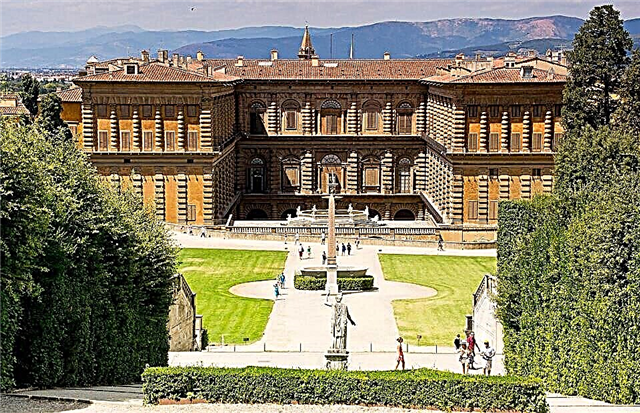Address: Russia, Yaroslavl region, Talitsy village
Foundation date: 1991 year
Coordinates: 56 ° 48'10.3 "N 38 ° 38'52.9" E
Content:
In the village of Talitsy, 18 km from the old Pereslavl-Zalessky, there is a museum that stores bulky "exhibits" - steam locomotives and railcars, diesel locomotives and carriages, cars and tractors, produced at the end of the 19th and the first half of the 20th centuries. Films and television series are often shot here. And in Russia, perhaps, it is difficult to find another place where the history of narrow-gauge railways would be so cherished.
History of the creation of the Museum of steam locomotives
The Locomotive Museum is officially called the Pereslavl Railway Museum. Earlier this unusual collection was called the Museum of Narrow Gauge Railways. Locals simply say about him - "Cuckoo". After all, this is what was previously called steam locomotives or trains running on narrow-gauge railways.

Steam locomotive Kp4-300
The museum was founded in 1991 as a private enterprise. For the first few years of his work, he presented a collection that could be viewed only by invitation. But since 1998, the steam locomotive museum has been open to everyone. And today the number of his guests reaches eight hundred a day. There is a fee to visit this museum. Free amateur photo and video filming is allowed on the territory.
Nowadays, more than 50 rare exhibits of railway and automobile equipment are collected here. Museum staff in Talitsy find them in different ways. Once upon a time, information about rarities rusting in the forest comes from old-timers. But often it is necessary to organize entire expeditions along the narrow-gauge branches marked on old maps. The found equipment is delivered to the museum mainly by road, and the long process of its restoration and restoration begins. The entire museum collection is displayed on the tracks of the small Talitsky station of the narrow-gauge railway and in the depot.

Steam locomotive Kp4-469
"Cuckoos"
The first narrow-gauge railways appeared in Russia in Altai at the beginning of the 18th century, and were used to develop the mining business. Later, they began to be built in large quantities in those places where there was no other transport. But by the end of the last century, it became not profitable to use narrow-gauge railways economically, and most of them were dismantled.
A similar history of narrow gauge railways exists in different countries of the world. But today they are trying to preserve the remaining sections of the tracks. They are specially redeemed, restored and made tourist attractions. There are museums of narrow-gauge railways, for example, in Griffitsa (Poland), in the suburb of Pärnu - Lavassaare (Estonia), in Anykschai (Lithuania), in the Carpathian Kolochava (Ukraine). Narrow-gauge railways are very popular, as they make it possible to feel the unity of nature and old technology, which ordinary railways do not have.

Pereslavskaya "Kukushka" is the only place on the Russian expanses where not only a section of tracks has been preserved, but also old railway equipment. Moreover, there are quite a few exhibits collected here. Many of them are unique and certified as monuments of the history of technology. Thanks to the work of the museum staff, its guests can get a complete picture of how the narrow-gauge railway network was arranged, what trains and carriages went along it, as well as how it was serviced and developed.
The Pereslavl narrow-gauge railway is a 2 km branch that leads from Talitsy to a clearing in the middle of Bludov swamp - a place described by the writer Mikhail Mikhailovich Prishvin in his story "The Pantry of the Sun". This narrow gauge railway was built and used for peat extraction.

Railway museum
The peculiarity of the Pereslavl Museum is that there are no stands, mock-ups and drawn tables. His collection consists of full-scale samples of railway and automobile equipment. They are either already restored to working condition, or are in the process of restoration. Moreover, restoration work is always a long process. Because you need to first find and familiarize yourself with the drawings. Then - to pick up the necessary spare parts or come up with technological solutions, when the necessary parts are no longer available. In addition, locomotives and carriages move around the museum territory as needed. So the exposition of the steam locomotive museum turns out to be "alive".
Even the exhibits that have not yet been restored, which in the eyes of an uninitiated visitor are only rusty ruins, are in fact of great historical value. If only because most of them have come down to our time in one single copy.

Two-axle diesel locomotive MD54-2
What can you see in the Talitsky Museum? First of all, these are, of course, old steam locomotives produced at factories in Russia, Poland, Germany and Finland from 1862 to 1958, including fragments of tank locomotives of the late 19th - early 20th centuries. The museum collection also contains old Russian motor and diesel locomotives, produced in the middle of the last century. Self-propelled rolling stock is represented by pre-war and post-war passenger, fire-fighting and local motorized tires.
Ordinary people who are not familiar with the history of railway transport in detail will find many interesting discoveries in the museum. For example, a big surprise is a railcar car, specially created in the 1960s for the travel of bosses on narrow-gauge roads.

The streamlined body of a ZiM passenger car (GAZ-12) looks very exotic on a narrow gauge track. Those who wish can even ride about 1 km (there and back) on a manual railcar, with a capacity of up to 6 people. This trip takes 10-15 minutes.
A large section of the museum exposition is carriages. They are very different here - passenger and freight, snowplows and timber trolleys. The museum has wagons that were used to transport peat, liquid tanks, dump wagons and flat wagons. The oldest exhibits in this section were released at the end of the 19th century in Russia and Germany.
In addition, in Talitsy you can see station equipment - a hand fire pump manufactured in St. Petersburg in the 1890s, a bell, scales used to weigh passengers' luggage (1928), one- and two-cylinder locomotives made in German and English factories at the end of the 19th and the beginning of the 20th centuries, as well as a set of Tegger's electric rod devices. They were used to regulate the movement of trains.

Shop car
Museum vehicle fleet
In addition to railway equipment, the museum has collected many old cars. At one time, most of them were active "partners" of narrow-gauge railways. Many cars were completely restored by the efforts of collectors, and are now used for filming. The entire auto collection can be viewed on a separate exhibition area, away from the main exhibition.
Trucks LiS-5 (1937), GAZ-51 (1963), GAZ-63 (1960), armored car FAI-M (1938), passenger car GAZ-67B (1948) were restored to a fully operational state. g.), as well as American cars of the Second World War Dodge WC-52 and Willis MB (1944). Now the museum specialists are restoring the famous Emka - GAZ-M1 (1939) and the Universal-2 wheeled tractor produced at the tractor plant in Vladimir (1947). In addition, in the museum, you can see two trucks-one and a half - GAZ-MM, produced in 1940 and 1949.

ZiM on rail
Souvenir shop car
Even souvenirs in the steam locomotive museum are sold in an unusual place. A small shop with railway symbols, toys and other memorabilia is housed in a mobile shop car. This two-axle covered wagon is unusual in itself. It was made in 1934 at a factory in Wismar, on the shores of the Baltic Sea.
Such shop cars have existed since the creation of the railway and provided people living at distant stations and in the surrounding villages with everything they needed - food, kerosene, clothes and shoes.Usually the bench car was hooked to a small train, and the goods were sold right at the stops. Customers could even leave an order - what to bring to their remote station next time.
Opening hours of the steam locomotive museum
The museum is open from 10.00 to 18.00. The days off are Monday and Tuesday. Guided tours are available upon prior request.
How to get to the steam locomotive museum
The Museum of Steam Locomotives is located 18 km from Pereslavl-Zalessky in the village of Talitsy (Leskhoznaya st., 1). You can reach it either by private car or by taxi.

Vehicle fleet in the museum
First, along the Yaroslavl highway (M8) you need to get to Pereslavl-Zalessky. From the city - turn towards Lake Pleshcheyevo (Prostornaya st.) Following the sign "Botik of Peter I". Further along the asphalt road, laid along the western shore of Lake Pleshcheevo, through Ves'kovo and Veslevo, drive to the village of Kupanskoye. A dirt road leads from here to Talits through the forest. At the turn, there is a sign "Museum of Steam Locomotives 3 km". The primer is quite passable for passenger cars.
In 15 km from the Pereslavl Railway Museum there is a museum of teapots and the estate-museum "Peter the Great's Boat".











